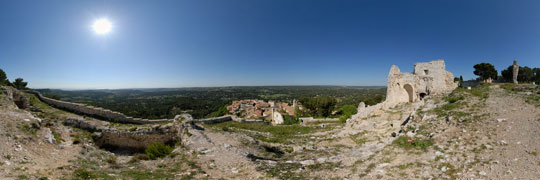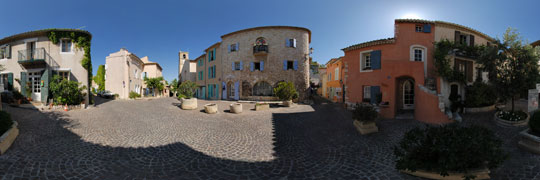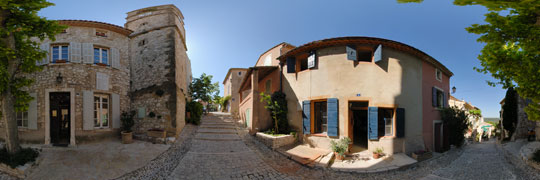Nice Panorama
- News :
- French Riviera :
- Provence :
- Var :
- Leisure :
- Economy :
- Gastronomy :
- Sport :
- Accommodation :
- Tourism :
- Site Map :
Ventabren : virtual tour of the old village
Ventabren is a village of the Bouches du Rhône located west of Aix-en-Provence, southeast of Salon-de-Provence and northwest of Marseille. Perched atop a hill, it is dominated by the ruins of the castle of Queen Jeanne, Queen of Naples and Countess of Provence.
History of the village of Ventabren
From its location atop a hill that dominates the countryside, the commune of Ventabren has always attracted people. Eight millennia BC, the Montadiens civilization, particular of low Provence, had settled his camp at Ventabren. One can still observe today a huge 20 m long snailery on the commune (the site is on the "oxen shelter" at a place called "La Plantade").
In 102 BC, the vast Roman entrenched camp (called "Marius Camp"), comprising two legions or 12,000 men, was located on the plateau (above the current location of the aqueduct of Roquefavour). Its traces are still clearly visible and comprise fortifications including a 600 m long wall protecting the camp on the north side (the other sides having cliffs for natural defense) and the location of three observation towers. Archaeological excavations have also helped find inside the camp some pottery and various pieces, evidence of the presence of a Celto-Ligurian city.
The origin of the castle of Ventabren must lie between 920-940 in the tenth century. It is linked to the presence of the Saracens in Provence who were devastating villages and pushing the populations on the heights to found here a safety they could no more have in the plain. Having definitely chased the Saracens, William I, Count of Provence, distributed the freed lands to his comrades in arms (see also the history of the lords of Fos who recuperated at this time the territories of Hyères). The latter were building fortifications including the castle of Ventabren, called at that time “the royal castle”.
The fortified castle was an important defensive work. Its architecture was very simple: its walls were measuring about 2 meters in thickness and were flanked by round and square towers. The castle had only one gate to the east. Other sides, built on steep rocks were absolutely inaccessible. Inside, there were some caves and a huge tank. A chapel was adjacent to the castle.
It is therefore likely that the village was built at the current location at this time, approaching as close as possible to the shelter offered by the medieval castle.
In the twelfth century, the castle of Ventrabren is part the seigniorial possession of Raymond of the Baux, as evidenced by a testamentary document in 1170.
In 1381, Louis I of Anjou, adopted son of Queen Jeanne, donated the castle to Bertrand of Agoult, a member of a powerful family of Provence.
Several families succeed with varying fortunes in possession of Ventabren: the castle becomes property of the Quiqueran in 1425, that of Bardelins in 1472 and belongs to Gaillard-Longjumeau in 1591 who held their lands of king Henry IV. These are the last lords of Ventabren. Early in the eighteenth century, they were no longer living in their castle but in their home of La Baronne.
If the fortress had withstood wars and time, it was destroyed in 1794, under the Republic. One then sought to destroy a castle "which recalled unfortunate memories". Nowadays, there are many carved stones of the castle in the walls of the village houses. Of the site of the ancient fortress, there are only the remains of many cellars of the castle (pillars, arches and semicircular arches), but they still reflect this impressive place loaded with history.
In the nineteenth century, the village of Ventabren was marked by the industrial progress. The arrival of the railway was inaugurated in 1857 (the line passes under the aqueduct of Roquefavour which was built a few years earlier (1842 to 1847) on the commune). Ventabren account then some plants and factories: one factory operating copper ore, a paper mill, laundry for linens, 4 mills, 6 oil mills.
Electric lighting arrived in the village in 1924.
Provence
Camargue
Alpilles
Pays Aixois
Luberon
Etang de Berre
La Côte Bleue

 Quicktime VR :
Quicktime VR :
 Java viewer :
Java viewer :

